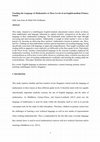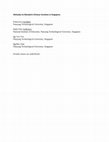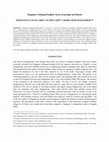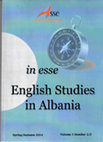Book by Mark Fifer Seilhamer
Multilingual Matters, 2019
This book presents the narratives of four Taiwanese young women, all proficient in English, set a... more This book presents the narratives of four Taiwanese young women, all proficient in English, set against the background of the dynamics of multilingualism in Taiwan. It chronicles their strategies and struggles when utilizing cultural goods-in this case their linguistic resources-to differentiate themselves within Taiwanese society.
Journal Articles by Mark Fifer Seilhamer
Journal of Language, Identity & Education

Oxford Review of Education, 2019
This study, situated in a multilingual, English-medium educational context, draws on theory from ... more This study, situated in a multilingual, English-medium educational context, draws on theory from mathematics and language education to capture teachers' perspectives on the place of language in their mathematics pedagogy. The benchmark study explored this topic through surveying and interviewing teachers. Additionally, it sought to relate teacher's views to their practice by focusing on observing three teachers' mathematics lessons at primary one, three, and five. Findings are that mathematics teachers placed importance on teaching language, being specifically concerned with language as input and comprehension. They taught vocabulary and reading skills in supportive ways explicitly yet differently at the three grade levels. Particularly at the lower levels, teachers contextualized language in the concrete examples employed for mathematics teaching. At all three levels, prominence was given to teaching pupils how to read word problems as well as how to solve them. However, at primary three, a tension was observed between the two aims of teaching mathematical vocabulary and teaching the reading skills for word problems. This paper illustrates the tension and discusses its possible causes.

Journal of Asian Pacific Communication, 2018
This study aims to shed light on the attitudes of Chinese Singaporeans and Chinese nationals resi... more This study aims to shed light on the attitudes of Chinese Singaporeans and Chinese nationals residing in Singapore to varieties of Mandarin Chinese. 64 Singaporean Chinese and Chinese national participants took matched and verbal-guise tests, evaluating recorded speakers of two varieties of Singapore Mandarin (standard and colloquial) and the variety spoken in the PRC on status and solidarity traits. These evaluations were followed by optional questionnaire items intended to probe for additional insights into the participants’ attitudes and perceptions of one another. Both Singaporean Chinese and Chinese national participants assigned higher status to the PRC’s variety of Mandarin. Attitudes toward the two varieties of Singapore Mandarin, however, varied, with Singaporeans rating the standard variety higher than the colloquial variety on all traits and Chinese nationals favouring the colloquial variety. Interestingly, for all three varieties of Mandarin, solidarity traits were rated higher than status traits by all participants, suggesting that, in Singapore, Mandarin Chinese is now viewed more as a language of solidarity than status.

Journal of Multilingual and Multicultural Development, 37(8), 817-831
Numerous studies have show... more Journal of Multilingual and Multicultural Development, 37(8), 817-831
Numerous studies have shown that some speech accommodation in interactions with the elderly can aid communication. Overaccommodaters, however, employing features such as high pitch, exaggerated prosody, and child-like forms of address, often demean, infantilise, and patronise elderly interlocutors rather than facilitate comprehension. According to the Communicative Predicament of Aging model, communication practices are determined by stereotypes of aging that are triggered in the minds of those interacting with the elderly. These stereotypes vary from culture to culture, and in Singapore, negative stereotypes of aging are prevalent, existing alongside traditional Confucian-influenced positive stereotypes. To date, no studies have examined whether or how stereotypes of aging might be manifested in interactions between younger and older Singaporeans. This investigation involved participant observation in a Singapore eldercare facility. Overaccommodation was indeed found to be employed by carers and varied qualitatively depending on the physical and cognitive abilities of the elderly, with healthy elderly addressed as one might address school-aged children and those with dementia addressed as infants. These results provide some initial insights into an issue that is extremely relevant to Singaporean society, given the city state's rapidly aging population.

World Englishes, Jul 6, 2015
ABSTRACT: Although applied linguists have long asserted that individuals who have learned English... more ABSTRACT: Although applied linguists have long asserted that individuals who have learned English as an additional language can rightly claim ownership of the language, this willingness on the part of academics to grant ownership to all users of English is ultimately of little consequence to the users themselves, who more often than not consider linguistic ownership to be determined solely by ethnicity or place of birth. This paper outlines a framework comprised of three aspects of language ownership—prevalent usage, affective belonging, and legitimate knowledge—and subsequently applies these concepts to a multi-case ethnographic study of English ownership (and lack thereof) among a group of Taiwanese English learners/users who privileged different ownership dimensions. Prevalent usage was found to be very important for achieving any degree of ownership, and the ability to make overt ownership claims ultimately depended on confidence and agency.

World Englishes, Sep 2014
ABSTRACT: Singapore Colloquial English (SCE) or ‘Singlish’ is a variety very distinct from Singa... more ABSTRACT: Singapore Colloquial English (SCE) or ‘Singlish’ is a variety very distinct from Singapore Standardised English (SSE), and its use is a polarising issue in Singaporean society. In stark contrast to the results of most language attitude studies in which non-standardised varieties are rated positively along solidarity dimensions, participants of matched-guise studies investigating Singaporean attitudes toward SCE have assigned lower solidarity ratings for SCE than for SSE. This is in stark contrast to anecdotal and public opinion that SCE is a language of solidarity and identity for most Singaporeans. By including participants from non-tertiary sectors and a wider range of stimulus guises as well as supplementing matched-guise results with interview data, this study seeks to reveal the covert prestige that SCE does, in fact, appear to enjoy in Singaporean society. While the matched-guise results of this study largely conform to previous findings, the interview data suggest that many participants were basing their ratings on perceptions of SCE use in the public domain rather than the private domain. The study has implications for the extent to which we can extrapolate results from matched-guise studies, a widely used instrument for the study of language attitudes in the last 50 years.

World Englishes, Sep 2014
ABSTRACT: With English use extremely prevalent in Singapore, young Singaporeans are increasingly... more ABSTRACT: With English use extremely prevalent in Singapore, young Singaporeans are increasingly abandoning the use of and emotional connections to their ethnic languages. The Singapore Malay community, however, is frequently depicted as an exception to this trend, proudly keeping Malay as their dominant language and an integral part of their cultural identities despite the overwhelming dominance of English in present day Singaporean society. This study seeks to obtain a sense of whether this is indeed the case by investigating the relationships Singaporean Malay university students (ages 18-26) have with Malay along the dimensions of language expertise, language inheritance, and language affiliation. 50 survey participants reported on their proficiency in, use of, and perceptions of Malay and English. The results indicate that participants’ relationships with Malay are indeed strongly characterized by all three dimensions – expertise, inheritance, and affiliation – despite their prevalent use of English in all but a few domains and, by the majority, identification of English as the language that best defines them as Singaporeans. Follow-up interviews with ten participants indicate that affiliation is strongly facilitated by the cultivation of a sense of language inheritance, but efforts to do so need not exclude English, nor do they necessarily need to be carried out in the home domain.
Keywords: affiliation, expertise, identity, inheritance, Malay, Singapore

In his memoirs, Singapore’s first prime minister Lee Kuan Yew bemoans the lack of a cohesive nati... more In his memoirs, Singapore’s first prime minister Lee Kuan Yew bemoans the lack of a cohesive national identity at the time of the republic’s founding in 1965. “How were we to create a nation out of a polyglot collection of migrants from China, India, Malaysia, Indonesia and several other parts of Asia?” he laments. Now, after nearly 50 years of nation-building, flag days, and National Day parades, a national identity for Singaporeans is still arguably very much in flux. Some
commentators have even characterised Singaporeans as being in the midst of an identity crisis, and such a characterisation may indeed be quite valid given the official shift in recent years from the cultivation of an imagined national community to encouraging Singaporeans to conceptualise the city state as a global city serving as a cross-road for a larger global imagined community. Accompanying this shift has been a massive influx of immigrants, which has impacted many Singaporeans’ sense of belonging and prompted increased debate on the issue of what constitutes a Singaporean identity. While some commonly proposed elements, such as pragmatism and a materialistic mind-set are, in fact, compatible with a global city identity, others, like Singaporean cuisine and Singlish, our home-grown vernacular, are decidedly more in line with a localised
national identity. This article reviews survey data, official discourse, and opinions expressed by Singaporeans in blogs and Internet chat boards in an effort to shed further light on this current hot-button issue of Singaporean identity.
English Today (http://journals.cambridge.org/action/displayJournal?jid=eng), Aug 16, 2013

The Language Teacher, 2013
Although Japanese English learners are well aware of the potential of English as a means to commu... more Although Japanese English learners are well aware of the potential of English as a means to communicate with the world, this remains an abstract concept for most, who have limited English interaction outside the classroom and continue to associate the language primarily with the people and cultures of traditionally English-speaking countries. Japanese university students, furthermore, tend to have less experience with international online English communication than their counterparts in many other countries. In this article, the author discusses several factors that contribute to the difficulty many Japanese students have conceptualizing themselves as members of an imagined global community of English users: the Japanese discourses of Nihonjinron and kokusaika, the Japanese translation and publishing industries, and a preference for domestic social networking websites. He concludes by advocating increased employment of international Internet exchange projects in Japanese English as a foreign language (EFL) classrooms as the best hope for facilitating membership in the imagined global community of English users.
Journal of Pragmatics (Copyright, Elsevier), 2011

NUCB Journal of Language, Culture and Communication, 2011
Prepositional verbs such as focus on, listen to, and account for are much more common in all regi... more Prepositional verbs such as focus on, listen to, and account for are much more common in all registers than phrasal verbs and are especially abundant in academic writing. These multi-word lexical items, however, tend to receive far less classroom attention than phrasal verbs and often prove to be a major source of error for even advanced learners of English. Through the examination of an academic writing sub-corpus of the British National Corpus, this study investigates the collocational strength of 192 different verb-preposition combinations in order to determine which ones collocate strongly enough to warrant their being taught as single lexical units. The verb-preposition combinations that collocate most strongly are presented and some implications of these findings for pedagogical practice in the area of prepositional verb instruction are subsequently discussed.
Book Chapters by Mark Fifer Seilhamer
Attitudes to English Study among Japanese, Chinese and Korean Women: Motivations, Expectations and Identity, 2021
Cognitive processing in second language acquisition: Inside the learner's mind, 2010
Book Reviews by Mark Fifer Seilhamer
Papers by Mark Fifer Seilhamer
Converging evidence in language and communication research, 2010











Uploads
Book by Mark Fifer Seilhamer
Journal Articles by Mark Fifer Seilhamer
Numerous studies have shown that some speech accommodation in interactions with the elderly can aid communication. Overaccommodaters, however, employing features such as high pitch, exaggerated prosody, and child-like forms of address, often demean, infantilise, and patronise elderly interlocutors rather than facilitate comprehension. According to the Communicative Predicament of Aging model, communication practices are determined by stereotypes of aging that are triggered in the minds of those interacting with the elderly. These stereotypes vary from culture to culture, and in Singapore, negative stereotypes of aging are prevalent, existing alongside traditional Confucian-influenced positive stereotypes. To date, no studies have examined whether or how stereotypes of aging might be manifested in interactions between younger and older Singaporeans. This investigation involved participant observation in a Singapore eldercare facility. Overaccommodation was indeed found to be employed by carers and varied qualitatively depending on the physical and cognitive abilities of the elderly, with healthy elderly addressed as one might address school-aged children and those with dementia addressed as infants. These results provide some initial insights into an issue that is extremely relevant to Singaporean society, given the city state's rapidly aging population.
Keywords: affiliation, expertise, identity, inheritance, Malay, Singapore
commentators have even characterised Singaporeans as being in the midst of an identity crisis, and such a characterisation may indeed be quite valid given the official shift in recent years from the cultivation of an imagined national community to encouraging Singaporeans to conceptualise the city state as a global city serving as a cross-road for a larger global imagined community. Accompanying this shift has been a massive influx of immigrants, which has impacted many Singaporeans’ sense of belonging and prompted increased debate on the issue of what constitutes a Singaporean identity. While some commonly proposed elements, such as pragmatism and a materialistic mind-set are, in fact, compatible with a global city identity, others, like Singaporean cuisine and Singlish, our home-grown vernacular, are decidedly more in line with a localised
national identity. This article reviews survey data, official discourse, and opinions expressed by Singaporeans in blogs and Internet chat boards in an effort to shed further light on this current hot-button issue of Singaporean identity.
Book Chapters by Mark Fifer Seilhamer
Book Reviews by Mark Fifer Seilhamer
Papers by Mark Fifer Seilhamer
Numerous studies have shown that some speech accommodation in interactions with the elderly can aid communication. Overaccommodaters, however, employing features such as high pitch, exaggerated prosody, and child-like forms of address, often demean, infantilise, and patronise elderly interlocutors rather than facilitate comprehension. According to the Communicative Predicament of Aging model, communication practices are determined by stereotypes of aging that are triggered in the minds of those interacting with the elderly. These stereotypes vary from culture to culture, and in Singapore, negative stereotypes of aging are prevalent, existing alongside traditional Confucian-influenced positive stereotypes. To date, no studies have examined whether or how stereotypes of aging might be manifested in interactions between younger and older Singaporeans. This investigation involved participant observation in a Singapore eldercare facility. Overaccommodation was indeed found to be employed by carers and varied qualitatively depending on the physical and cognitive abilities of the elderly, with healthy elderly addressed as one might address school-aged children and those with dementia addressed as infants. These results provide some initial insights into an issue that is extremely relevant to Singaporean society, given the city state's rapidly aging population.
Keywords: affiliation, expertise, identity, inheritance, Malay, Singapore
commentators have even characterised Singaporeans as being in the midst of an identity crisis, and such a characterisation may indeed be quite valid given the official shift in recent years from the cultivation of an imagined national community to encouraging Singaporeans to conceptualise the city state as a global city serving as a cross-road for a larger global imagined community. Accompanying this shift has been a massive influx of immigrants, which has impacted many Singaporeans’ sense of belonging and prompted increased debate on the issue of what constitutes a Singaporean identity. While some commonly proposed elements, such as pragmatism and a materialistic mind-set are, in fact, compatible with a global city identity, others, like Singaporean cuisine and Singlish, our home-grown vernacular, are decidedly more in line with a localised
national identity. This article reviews survey data, official discourse, and opinions expressed by Singaporeans in blogs and Internet chat boards in an effort to shed further light on this current hot-button issue of Singaporean identity.